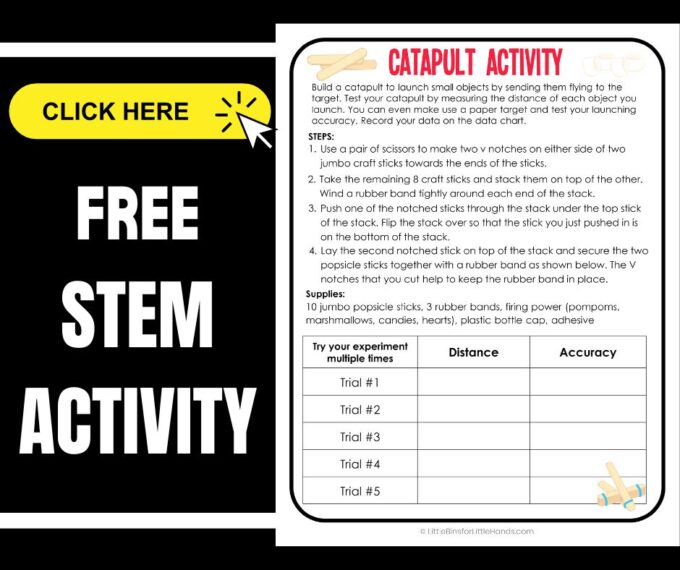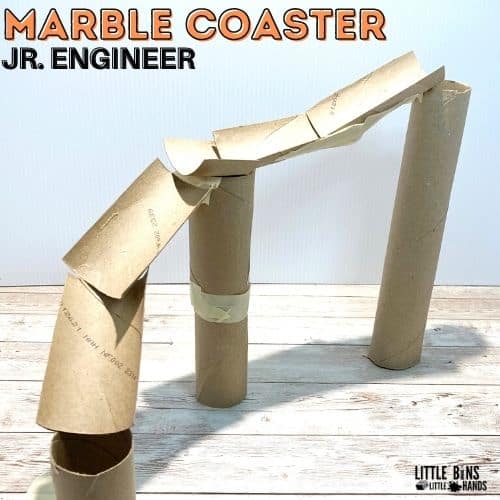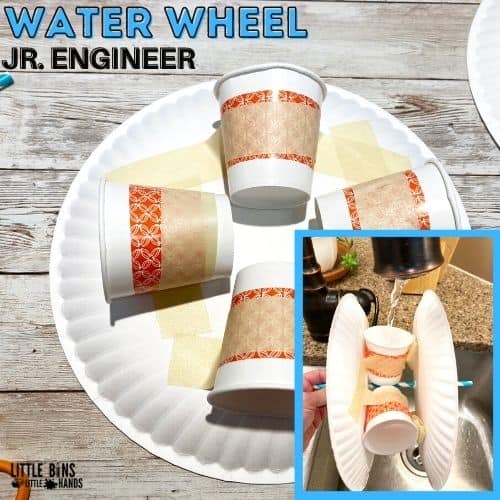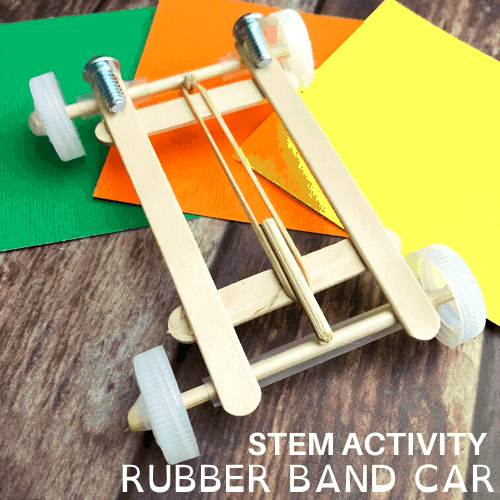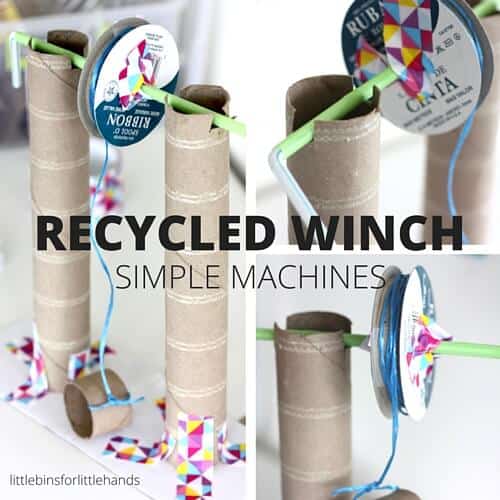Energy is the force that makes things happen. It makes toys move, water flow, and lights glow. There are different types of energy, and two important ones are potential energy and kinetic energy. Let’s explore the difference between the two and look at some fun examples to help kids understand these concepts better.
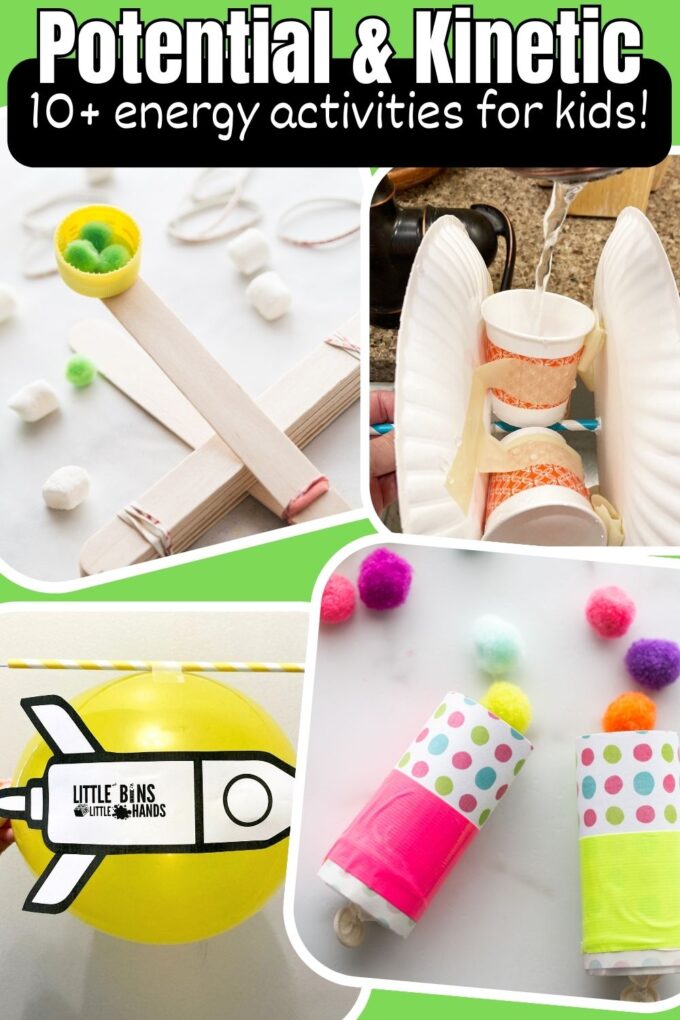
Tips For Explaining Potential & Kinetic Energy To Kids
Teaching potential and kinetic energy to kids can be engaging and fun with the right approach. Here a few tips to make the concepts of potential and kinetic energy accessible and enjoyable for young learners.
TIP 1: Use simple, hands-on experiments and demonstrations to illustrate the concepts. We have tons of fun activities below for you to use.
TIP 2: Relate potential and kinetic energy to everyday situations. For potential energy, discuss how a ball on a shelf or water in a dam has stored energy. For kinetic energy, use examples like running, bouncing balls, or moving vehicles. Check out more everyday examples below.
TIP 3: Engage children in interactive activities or games. Have them jump, swing, or roll objects to experience kinetic energy firsthand. Encourage them to identify examples of potential and kinetic energy in their surroundings.
TIP 4: Use language that kids can relate to. Explain potential energy as “stored energy” or “ready-to-go energy” and kinetic energy as “energy in motion” or “moving energy.” Avoid overly technical terms and jargon.
Remember to keep the explanations age-appropriate, encourage questions, and provide opportunities for children to explore and discover these concepts on their own.
For more ways to explore physics with kids, check out our list of easy physics experiments.
What Is Potential Energy?
Potential energy is a form of mechanical energy that an object has due to its position or state. It is energy that is stored within an object and has the potential to do work in the future if certain conditions are met.
For example, a rubber band that is stretched between your fingers has potential energy. The energy stored in the stretched rubber band, is ready to be released when you let go.
There are two main types of potential energy:
Gravitational Potential Energy
Gravitational energy is the special energy that objects have because of the pull of gravity. Gravity is the invisible force that pulls everything toward the center of the Earth. It’s what keeps us on the ground and makes things fall when we drop them.
Related Idea: Gravity Experiments For Kids
When something is lifted or raised up above the ground, like a ball on a shelf or a book on a desk, it gains gravitational energy. It’s like it’s storing energy, waiting for a chance to fall.
The higher an object is above the ground, the more gravitational energy it has. Imagine a ball at the top of a slide—it has a lot of gravitational energy because it’s high up.
When you let go of something, like dropping a ball or opening a book, the stored gravitational energy turns into motion. The object falls or moves down because of gravity, and this energy is now kinetic energy, which means energy in motion.
Elastic Potential Energy
This type of potential energy is to do with the stretching of elastic materials, such as a spring or a rubber band. When a spring or elastic material is compressed or stretched, it stores elastic potential energy. This energy is released when the material returns to its original shape.
Examples of Potential Energy
Here are some everyday examples of potential energy…
- Raised Objects: Any object lifted above the ground has gravitational potential energy. For example, a book on a shelf, a hanging light fixture, or a child on a swing.
- Stretched Elastic Bands: When you stretch a rubber band or an elastic hair tie, you’re storing elastic potential energy in the material. When you release it, the stored energy is converted into kinetic energy as the band snaps back to its original shape.
- Climbing a Staircase: As you climb a flight of stairs, you gain potential energy with each step you take. The higher you go, the more potential energy you gain.
- Charged Batteries: Batteries store chemical potential energy. When you use a battery to power a device, it converts this stored energy into electrical energy, which is then used to perform work.
- Water Behind a Dam: In hydroelectric power systems, large volumes of water are held behind a dam at a higher position. This water has gravitational potential energy, which is converted into electrical energy when the water flows downhill through turbines.
- Compressed Springs: Mechanical devices like clocks and toys often use springs that are wound or compressed. These springs store elastic potential energy, which is released as the spring unwinds or expands to power the device.
- Raised Weights in Exercise Equipment: When you lift weights in a gym, you are providing potential energy to the weights by raising them against gravity. The higher you lift them, the more potential energy they gain.
- Stretched Bungee Cord: Before a bungee jump, the bungee cord is stretched and gains elastic potential energy. As the jumper falls, this stored energy slows down and eventually stops their descent.
- Food on a Shelf: Items stored on shelves or in cupboards have gravitational potential energy relative to the floor. When you take an item off a shelf, you’re using its potential energy.
- Drawn Bowstring: In archery, when you draw the bowstring, you’re storing elastic potential energy in the bow. When you release the string, this energy is converted into kinetic energy, propelling the arrow forward.
What Is Kinetic Energy?
Kinetic energy is the energy an object has due to its motion. For example; when a bike is moving, the rotating wheels have kinetic energy. The faster the cyclist pedals, the more kinetic energy is generated.
A few things to note about kinetic energy…
- The kinetic energy of an object depends on both its mass and its speed. An object with greater mass or higher speed will have more kinetic energy. For example; A heavier object at the same speed will have more kinetic energy than a lighter object.
- The change in an object’s kinetic energy is directly proportional to the net work done on the object. When work is done on an object (either to speed it up or slow it down), its kinetic energy changes accordingly.
- Kinetic energy can be converted into other forms of energy and vice versa. For example, when a moving car brakes, its kinetic energy is converted into heat energy due to friction.
Examples of Kinetic Energy
Here are some everyday examples of kinetic energy…
- Moving Vehicles: Cars, buses, bicycles, and motorcycles all have kinetic energy when they are in motion. The faster they are moving, the more kinetic energy they have.
- Running: When a person runs, they have kinetic energy due to their motion. The faster they run, the more kinetic energy they have.
- Children Playing: Kids at a playground running, jumping, and playing have kinetic energy as they move around.
- Swinging Pendulum Clocks: The pendulum in a clock swings back and forth, demonstrating the conversion of potential energy (at the highest point) to kinetic energy (at the lowest point).
- Wind Turbines: Wind turbines convert the kinetic energy of moving air (wind) into mechanical energy, which is then converted into electrical energy.
- Fan Blades: When a fan is turned on, the blades rotate, creating air movement. The kinetic energy of the spinning blades is transferred to the air, creating a breeze.
- Tennis Ball in Flight: A tennis ball in flight, whether hit by a racket or thrown through the air, possesses kinetic energy due to its motion.
- Moving Water: Water flowing in rivers or streams has kinetic energy as it moves downhill. This kinetic energy can be harnessed for hydroelectric power.
- Rotating Bicycle Wheels: When a bicycle is in motion, the rotating wheels have kinetic energy. The faster the cyclist pedals, the more kinetic energy is generated.
- Rolling Objects: Everyday objects like a rolling ball, a skateboard in motion, or a suitcase being pulled all have kinetic energy as they move across a surface.
What Is The Difference Between Kinetic and Potential Energy?
Potential energy is the energy of position or stored energy. It’s the energy something has because of where it is or how it’s positioned, like a ball on a shelf, a stretched rubber band, or a raised bike. Think of it as “ready-to-go energy.”
Kinetic energy is the energy of movement. It’s the energy something has when it’s moving, like a rolling ball, a running dog, or a swinging pendulum. Think of it as “energy in action.”
The key difference…
Kinetic energy is when things are already moving, like a moving car. Potential energy is when things are ready to start moving but haven’t yet, like a parked car on a hill.
So, kinetic energy is energy in motion, and potential energy is energy waiting to be put into motion. Both are essential in understanding how things work and how energy changes from one form to another.
The next time you see something move or something ready to move, remember that it’s all about potential and kinetic energy working together to create the amazing dance of the world around us!
Kinetic and Potential Energy Activities
From roller coasters bouncing balls, a pendulum swing and more, engaging in hands-on activities that demonstrate potential and kinetic energy is a great way for kids to understand these concepts. Here are potential and kinetic energy activities suitable for elementary to middle school:
For Elementary Students
Catapult
Build your own catapult from Popsicle sticks or come up with your own design. Talk about how a catapult works when potential energy stored in a stretched rubber band is converted to kinetic energy. Check out how to make a catapult.
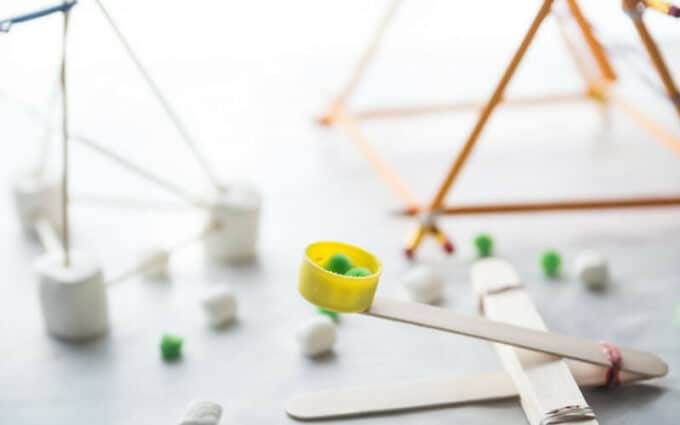
Bouncing Ball
Compare the bounce of different balls, such as basketball, tennis, and rubber balls. Discuss how each ball stores and releases energy when it hits the ground.
Spring Toy Launch
Use a spring-loaded toy like a wind-up car or a toy launcher. Wind it up and release it to observe how the stored energy is converted into kinetic energy.
Ramp Racing
Set up a ramp (a board or a piece of cardboard) and race toy cars down it. Experiment with different angles of the ramp to demonstrate how the height of the ramp affects the speed and kinetic energy of the cars. Check out these fun ways to experiment with ramps using pumpkins, toy cars, Easter eggs.
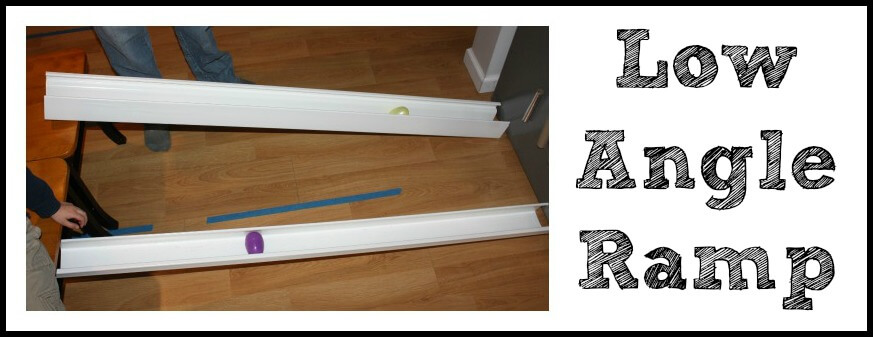
Bike Ride
If a child has a bicycle, explain how pedaling uphill requires effort to increase potential energy, and going downhill converts that potential energy into kinetic energy. Go for a bike ride on a hilly path to demonstrate this concept.
Jumping Off a Chair
Have the child jump off a low chair or stool onto a soft surface like a carpet. Discuss how they gain potential energy when they’re on the chair and convert it into kinetic energy when they jump.
Swing Set Fun
Swinging on a swing set is a great way to experience potential and kinetic energy. Pushing the swing higher increases potential energy, and as it swings back down, it converts to kinetic energy.
Balloon Rocket
Blow up a balloon, and watch it fly! Discuss how a balloon stores store potential energy through air pressure. When you release the balloon, the air rushes out, propelling the balloon forward. You can also try a balloon car!
Slingshot Launch
Use a safe, child-friendly slingshot to launch soft projectiles (like foam balls) into the air. Discuss how pulling back the slingshot stores energy and releasing it converts that energy into kinetic energy. Check out to make a pom pom shooter.

For Middle School Students
Through hands-on lab activities, middle school students can deepen their understanding of potential and kinetic energy. Encourage students to record data, make observations, and draw conclusions to reinforce their understanding of the concepts.
Here are some potential and kinetic energy labs:
Roller Coaster Design
Have students design and build small roller coasters using foam tubing, cardboard, or other materials. They can experiment with different heights and track shapes to observe how potential energy affects kinetic energy. Check out how to make a marble roller coaster.
Pendulum Investigation
Set up a simple pendulum with a string and a weight (like a washer or a small ball). Students can vary the string length and measure the pendulum’s swing to study the relationship between potential and kinetic energy.
Water Wheel
Construct a water wheel from a paper plate and cups. Discuss how the water flows and fills the cups, as it demonstrates the conversion of potential energy into kinetic energy.
Spring Scale Exploration
Provide spring scales and objects of different weights. Have students lift the objects and record the potential energy, then release them to measure the kinetic energy as they fall. Discuss the concept of gravitational potential energy.
Rubber Band Car
Create a rubber band powered car using popsicle sticks and a rubber band. Students can twist the rubber bands to store potential energy, released as kinetic energy as the car moves. Check out how to make a rubber band car.
Bouncing Ball Drop
Drop different types of balls (e.g., basketball, tennis ball, rubber ball) from a fixed height and measure the height of their bounces. Discuss how potential energy converts to kinetic energy and back.
Marble Run Challenge
Create a variety of marble runs with different track lengths, heights, and inclines. Students can release marbles from various starting points to investigate how potential energy affects speed and kinetic energy.

Slope and Energy Conservation
Set up an inclined plane and roll a ball down it. Have students measure the ball’s speed at different points along the slope and calculate its potential and kinetic energy at each position.
Energy Transformation Stations
Create stations with different energy transformations, such as a hand-crank generator that converts mechanical energy into electrical energy, or a wind-up toy that converts potential energy into kinetic energy. Students can rotate through these stations and discuss the processes involved.
Hand Crank Winch
Build a hand-crank winch from simple materials and demonstrate potential energy in action. Attach a lightweight object to the winch and calculate potential energy gained by the object as its raised. You could also try a pulley system.
Helpful Science Resources To Use
Here are a few resources that will help you introduce science more effectively to your kiddos or students and feel confident yourself when presenting materials. You’ll find helpful free printables throughout.
- Best Science Practices (as it relates to the scientific method)
- Science Vocabulary
- 8 Science Books for Kids
- All About Scientists
- Science Supplies List
- Science Tools for Kids
- Join us in the Club
Science Experiments By Age Group
We’ve put together a few separate resources for different age groups, but remember that many experiments will cross over and can be re-tried at several different age levels. Younger kiddos can enjoy the simplicity and hands-on fun. At the same time, you can talk back and forth about what is happening.
As children get older, they can bring more complexity to the experiments, including using the scientific method, developing hypotheses, exploring variables, creating different tests, and writing conclusions from analyzing data.
- Science for Toddlers
- Science for Preschoolers
- Science for Kindergarten
- Science for Early Elementary Grades
- Science For 1st Grade
- Science for 3rd Grade
- Science for Middle School
Printable Science Projects For Kids
If you’re looking to grab all of our printable science projects in one convenient place plus exclusive worksheets and bonuses like a STEAM Project pack, our Science Project Pack is what you need! Over 300+ Pages!
- 90+ classic science activities with journal pages, supply lists, set up and process, and science information. NEW! Activity-specific observation pages!
- Best science practices posters and our original science method process folders for extra alternatives!
- Be a Collector activities pack introduces kids to the world of making collections through the eyes of a scientist. What will they collect first?
- Know the Words Science vocabulary pack includes flashcards, crosswords, and word searches that illuminate keywords in the experiments!
- My science journal writing prompts explore what it means to be a scientist!!
- Bonus STEAM Project Pack: Art meets science with doable projects!
- Bonus Quick Grab Packs for Biology, Earth Science, Chemistry, and Physics


